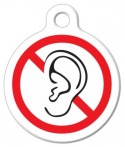
The last week of September is Deaf Dog Awareness week. If you’ve ever had a deaf dog or a dog with hearing loss, you know that it takes a little extra care to communicate with these special dogs, but once you do you’ll have a faithful friend for life.
Growing up, my pup, Sam, was my most devoted companion. When I’d come home from school he’d race upstairs to greet me with joy. Later, when I started driving, he knew the sound of my car and would wait for me by the front door as soon as I pulled up to the house.
As a senior dog, that changed.
| When I started coming home from college, I noticed that Sam no longer raced to meet me by as soon as I came inside. He’d slowed down a bit, true, but that wasn’t it. If he was asleep, he wouldn’t come when I called his name. Over time, we knew that Sam was losing his hearing, and in the last years of his life he was almost completely deaf. To honor Sam, and to pay tribute during Deaf Dog Awareness week, I thought I’d write a post with some pointers on caring for a deaf dog. |  |
Signals, Signals, Signals
The main difference between deaf dogs and dogs that can hear, is how you communicate with them. Because they can’t hear, deaf dogs are reliant on visual cues, and this is where hand signals come in.
With Sam, we used a series of hand signals that were similar to the signals we naturally used when giving commands like “sit,” “stay,” “go,” “come,” etc. If you have a deaf pup that you’re training, you can use signals from American Sign Language. When your dog’s outside at night, you can train them to come by flashing a light.
Reward Your Pup
Positive reinforcement is the way to go when teaching your deaf pup new command signals. Make sure you reward your dog handsomely when training – it’s amazing how fast they’ll catch on when motivated by hot dogs or some other tasty morsels.
ID Tag Safety
It’s important to have updated pet ID tags with your current phone number that identifies your dog as deaf. Deaf dogs can’t hear oncoming traffic, and they may be extra skittish if they get out and get separated from their owner. If someone finds your lost pet, personalized pet tags can provide crucial information about the animal. They will know they’re deaf, and keep them safe until you can be reunited.
On Leash
It’s important to keep your deaf pooch on a leash when you’re out and about. The last thing you want is for them to break away, say, after a squirrel on a trail, and then not be able to call them back. There are vibrating dog collars on the market for deaf dogs that send a signal to alert the dog to their owner, although with positive reinforcement and treat training your deaf pooch will learn to look at you and “check in” at intervals.
Gentle Touch
Introduce gentle touch early to get your pup’s attention, when signal training, or to wake them gently. If you take your dog to a dog park or other places for socializing, you can touch your dog when another dog approaches from behind and point out the other dog so that he or she isn’t startled by a surprise visitor.
For more resources on training your deaf dog, and to be connected to a community of people who own dogs that are deaf, check out Deaf Dogs Rock.




| Kathleen McCafferty has been told more than once that she has “selective hearing” and she thought the same was true for Sam, her senior dog, until she realized he had hearing loss. This Deaf Dog Awareness Week, she’s thinking of Sam, as well as all the other deaf dogs out there who have big hearts and deserve to “hear” nothing but praise. |

